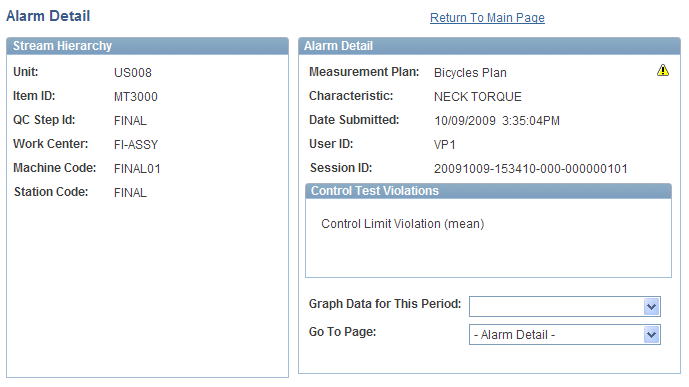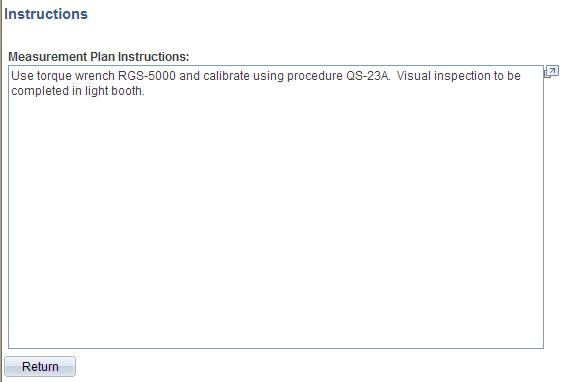Viewing Alarms
To define alarm access profiles, use the Define Alarm Review Criteria component (QS_ALM_ACCLIST). This topic provides an overview of alarm access profiles and discusses how to view Alarms.
|
Page Name |
Definition Name |
Usage |
|---|---|---|
|
QS_ALM_ACCLIST |
Define an alarm access ID that specifies the selection criteria for alarm review. |
|
|
QS_ALM_RVW_INQ |
View alarms that match the selection criteria that you specified on the alarm access profile. |
|
|
QS_ALM_RVW_DET |
View the detailed information associated with the alarm. From this page you can access other pages, where you can review a chart, enter probable causes for the alarms, or log corrective actions. |
|
|
Summarize Alarm Attributes Page |
QS_ANLZ_ALMSUM_SPG |
Select the attribute that you want to analyze and then have the system create a Pareto chart of that attribute. |
|
QS_INSTRUCT_PNL |
View the control plan instructions where an alarm occurred. |
|
|
QS_TRCDET_PNL |
View the actual sample values for the subgroup and trace fields that were entered for the subgroup. |
Quality analyzes data that you enter online and generates alarms if a control violation occurs for the process. When an alarm occurs, operators can take immediate action to correct the problem, or a quality analyst can review and monitor the alarms at a later date, enter causes for the alarms, and log corrective actions.
To facilitate alarm review and reduce review time for multiple alarms, create an alarm-access profile where you specify the processes or control plans that you want to view on an ongoing basis. You can also:
View alarms of a relative age for which causes or corrective actions have not been taken.
View only alarms where some action has been taken.
View both types of alarms.
Use the Define Alarm Review Criteria page (QS_ALM_ACCLIST) to define an alarm access ID that specifies the selection criteria for alarm review.
Navigation:
Field or Control |
Description |
|---|---|
Recall Alarms of Type |
Select a type of alarm to recall. |
Review Period Days |
Enter the relative age of alarms that you want to review. The system returns alarms based on the number of days specified subtracted from the current date. |
Selection Criteria
These fields are the hierarchy fields associated with the quality function that you select. Select one of the following qualifiers next to each hierarchy field, and enter the appropriate data expression that goes with the qualifier.
Field or Control |
Description |
|---|---|
<> |
Select alarms where the hierarchy field is not equal to the value. |
= |
Select alarms where the hierarchy field is equal to the value. |
ALL |
All entries are returned. There is no qualification on this field. |
BETWEEN |
Select alarms between two hierarchy values that you enter. |
LIKE |
Select alarms where the field is like or similar to the value. The % sign is used as the wildcard. |
For example, if you specify item ID as a hierarchy field, and you enter an item ID of LIKE and 30%, then with this expression, the system retrieves all alarms associated with items starting with the number 30. The % character denotes the wildcard position and is used anywhere in the value string. The system uses the % character to form the search pattern for the item.
When using the BETWEEN qualifier, you must separate the expression by commas. For example, if you want to retrieve alarms associated with a particular set of work centers, you enter BETWEEN WC10001, WC20001. With this expression, the system retrieves alarms associated with the work centers between those two values.
Use the Review Alarms page (QS_ALM_RVW_INQ) to view alarms that match the selection criteria that you specified on the alarm access profile.
Navigation:
This example illustrates the fields and controls on the Review Alarms page: Stream Hierarchy tab. You can find definitions for the fields and controls later on this page.

Make sure that an alarm access profile has been defined and alarms have been generated against control plans to populate the page.
Note: To enhance security, the Alarm Access ID field does not provide a prompt list.
The first columns to appear depend on the quality function that you select. The columns are the hierarchy fields associated with the quality function.
Field or Control |
Description |
|---|---|
Date Submitted |
Displays the date and time that the alarm occurred. |
Characteristic |
Displays the characteristic where the alarm was generated. Click the Characteristic (Display Detail) link to access the Alarm Detail page. |
Summary Analysis |
Click this link to view a Pareto chart of various alarm-related attributes. |
Alarm Status Tab
Select the Alarm Status tab.
Field or Control |
Description |
|---|---|
Test Violations |
Displays the number of test violations that caused the alarm to trigger. The alarm is tagged to a specific subgroup, where up to three test violations can be detected for each subgroup: means and variance charts and specification violation. |
Cause Count |
Displays the number of probable causes previously entered against this alarm. |
Action Count |
Displays the number of corrective actions previously logged against this alarm. |
Use the Alarm Detail page (QS_ALM_RVW_DET) to view the detailed information associated with the alarm.
From this page you can access other pages, where you can review a chart, enter probable causes for the alarms, or log corrective actions.
Navigation:
Click a Characteristic (Display Detail) link on the Review Alarms page.
This example illustrates the fields and controls on the Alarm Detail page. You can find definitions for the fields and controls later on this page.

This page displays all the relevant subgroup information associated with a specific alarm.
Stream Hierarchy
The system displays the hierarchy fields associated with the quality function.
Alarm Detail
The system displays the basic information about the alarm, including the session ID associated with the alarm.
Field or Control |
Description |
|---|---|
Graph Data for This Period |
Select the type of graph that you want. Values are Control Chart, Histogram, Pareto of Alarms, Pareto of Comments, Pareto of Corrective Actions, Pareto of Defects, and Pareto of Probable Causes. |
Control Test Violations
Displays the control-test violations associated with the alarm. There can be up to three test violations per alarm.
Additional Links
You can link to other pages using the Go To Page field to enter corrective and probable cause actions and sample details.
Use the Instructions page (QS_INSTRUCT_PNL) to view the control plan instructions where an alarm occurred.
Navigation:
Select the View Instruction option for the Go To Page field on the Alarm Detail page.
This example illustrates the fields and controls on the Instructions page. You can find definitions for the fields and controls later on this page.

The system displays the measurement plan instructions that are associated with the control plan.
Use the Sample Values / Traceability Detail page (QS_TRCDET_PNL) to view the actual sample values for the subgroup and trace fields that were entered for the subgroup.
Navigation:
Select the Sample Detail option for the Go To Page field on the Alarm Detail page.
This example illustrates the fields and controls on the Sample Values / Traceability Detail page. You can find definitions for the fields and controls later on this page.

The page displays the sample details and trace field information associated with the subgroup when the alarm occurred.
Field or Control |
Description |
|---|---|
Sample |
Displays the sample number. |
Reading |
Displays the sample or measurement value. |
User ID |
Displays the user ID of the operator who performed the data collection (applies only to manual data entry). |
Any/all traceable fields |
Displays the trace field values that are tagged to samples for this subgroup. |